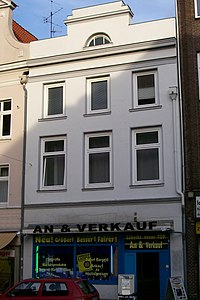Great Burgstrasse (Lübeck)

The Große Burgstraße in the Hanseatic city of Lübeck opens up the old town from the north.
Geography and course
Originally, this access was the only land access to today's inner city. With the construction of the Elbe-Lübeck Canal , however, with the piercing of the headland in front of the castle gate, it became an island between the canal and the city trave . The Wakenitz , which previously closed off Lübeck to the east, was dammed and diverted through a culvert under the canal into the city trave. The suburb of St. Gertrud begins in front of the Burgtor with the Burgfeld ( Gustav Radbruch- Platz) .
In the Middle Ages, the Große Burgstrasse in the Jakobi Quartier served as a break for wagons and carriages from the north-eastern Mecklenburg region with numerous inns . It begins behind the Burgtorbrücke built in the course of the canal construction over the Klughafen am Burgtor and runs to Koberg with the Holy Spirit Hospital and the Jakobikirche . From there on, according to medieval town planning, the north-south development of Lübeck is divided into Königstrasse and Breite Strasse .
buildings
The old Lübeck castle , which is still preserved in other medieval remains in the form of the brick Gothic castle monastery , today contains the European Hanseatic Museum . The ensemble of the castle gate includes the former stables and the customs office ( No. 5 ), both of which merge into the other Lübeck city fortifications with the remains of the city wall that have been preserved here .
Große Burgstrasse No. 4 , today's State Office for Social Services , was built as a court house in 1894/1896 as a forerunner of today's court house, which was inaugurated at Burgfeld 7 in 1962, based on a design by Lübeck building director Adolf Schwiening with a Gothic facade. Its monumentality shows that even in this phase the city planners paid little attention to the standards of the medieval city. Because it replaced no less than five small houses. In the rear part of the building, parts of the former monastery complex were preserved and integrated into the building. Today the former cells of the remand prison and a hearing room of the former regional court with the interior as a memorial for victims of justice of the Third Reich , including the Lübeck martyrs , are still preserved and can be reached via the rear castle monastery in the European Hanseatic Museum.
From 1588 on, the Bishop's Hostel , the Lübeck town house of the bishops of Ratzeburg and, after 1648, the Dukes of Mecklenburg were located at Grosse Burgstrasse No. 11 . From 1720 it was used as an inn, from 1841 under the name of Grand Duke of Mecklenburg . The renaissance of the renovation period of 1598/99 dominates behind the neo-classical facade at the beginning of the 19th century.
In 1871, at Grosse Burgstrasse 25 , Clara Roquette founded the Roquettesche Höhere Töchterschule, from which the Roquettesche private teachers' seminar emerged.
The piece and bell founders Hinrik van Kampen and Karsten Middeldorp lived one after the other in house number 47 in the 16th century .
Monument protection
Under conservation building 53 are in the Great Castle Road 5, 7, 11, 17, 35, on the odd side and 2, 4, 22-26, 38, 42 straight.
- building
Große Burgstrasse with a view of the castle gate, Daguerrotyopie by Joseph Wilhelm Pero , before 1847

Corridors and courtyards
Walk from the Große Burgstraße or walk from the following Lübeck corridors and courtyards (according to house numbers):
- 37 Rademacher Gang (discontinued after redevelopment in the 1820s)
- 41 Käselaus Gang
literature
- Manfred Finke: Great Burgstrasse. In: Manfred Finke: 116 times Lübeck. Monument protection, renovation, new architecture. 25 years of dealing with a city monument. Schmidt-Römhild, Lübeck 2000, ISBN 3-7950-1239-2 , p. 101.
- Hans Ewers: The history of the Lübeck court house in Burgstrasse. In: Schleswig-Holstein advertisements . Special issue March 1962 = special issue for the inauguration of the new Lübeck court house on March 8, 1962, pp. 56–62.
Web links
See also
Coordinates: 53 ° 52 ′ 21.5 ″ N , 10 ° 41 ′ 26 ″ E







